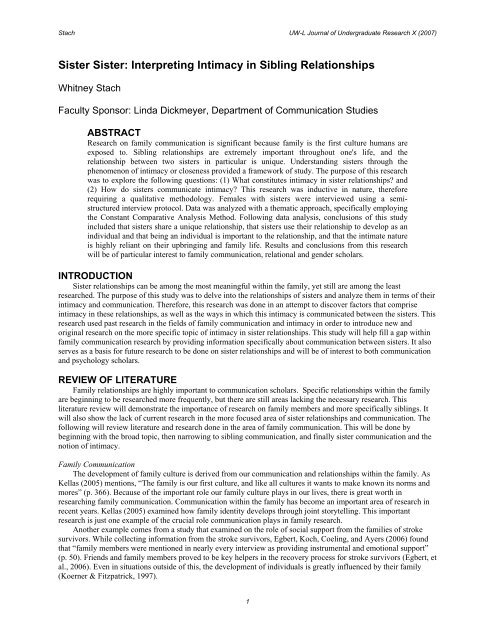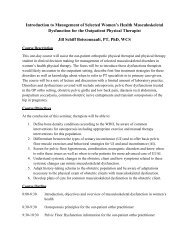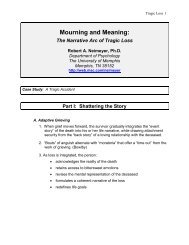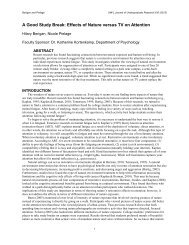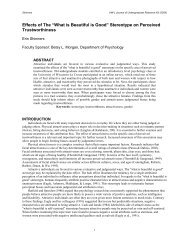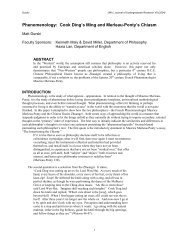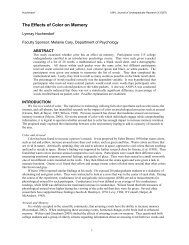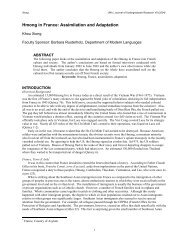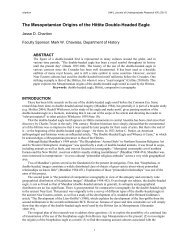Sister Sister: Interpreting Intimacy in Sibling Relationships
Sister Sister: Interpreting Intimacy in Sibling Relationships
Sister Sister: Interpreting Intimacy in Sibling Relationships
You also want an ePaper? Increase the reach of your titles
YUMPU automatically turns print PDFs into web optimized ePapers that Google loves.
Stach UW-L Journal of Undergraduate Research X (2007)<br />
<strong>Sister</strong> <strong>Sister</strong>: <strong>Interpret<strong>in</strong>g</strong> <strong>Intimacy</strong> <strong>in</strong> Sibl<strong>in</strong>g <strong>Relationships</strong><br />
Whitney Stach<br />
Faculty Sponsor: L<strong>in</strong>da Dickmeyer, Department of Communication Studies<br />
ABSTRACT<br />
Research on family communication is significant because family is the first culture humans are<br />
exposed to. Sibl<strong>in</strong>g relationships are extremely important throughout one's life, and the<br />
relationship between two sisters <strong>in</strong> particular is unique. Understand<strong>in</strong>g sisters through the<br />
phenomenon of <strong>in</strong>timacy or closeness provided a framework of study. The purpose of this research<br />
was to explore the follow<strong>in</strong>g questions: (1) What constitutes <strong>in</strong>timacy <strong>in</strong> sister relationships? and<br />
(2) How do sisters communicate <strong>in</strong>timacy? This research was <strong>in</strong>ductive <strong>in</strong> nature, therefore<br />
requir<strong>in</strong>g a qualitative methodology. Females with sisters were <strong>in</strong>terviewed us<strong>in</strong>g a semistructured<br />
<strong>in</strong>terview protocol. Data was analyzed with a thematic approach, specifically employ<strong>in</strong>g<br />
the Constant Comparative Analysis Method. Follow<strong>in</strong>g data analysis, conclusions of this study<br />
<strong>in</strong>cluded that sisters share a unique relationship, that sisters use their relationship to develop as an<br />
<strong>in</strong>dividual and that be<strong>in</strong>g an <strong>in</strong>dividual is important to the relationship, and that the <strong>in</strong>timate nature<br />
is highly reliant on their upbr<strong>in</strong>g<strong>in</strong>g and family life. Results and conclusions from this research<br />
will be of particular <strong>in</strong>terest to family communication, relational and gender scholars.<br />
INTRODUCTION<br />
<strong>Sister</strong> relationships can be among the most mean<strong>in</strong>gful with<strong>in</strong> the family, yet still are among the least<br />
researched. The purpose of this study was to delve <strong>in</strong>to the relationships of sisters and analyze them <strong>in</strong> terms of their<br />
<strong>in</strong>timacy and communication. Therefore, this research was done <strong>in</strong> an attempt to discover factors that comprise<br />
<strong>in</strong>timacy <strong>in</strong> these relationships, as well as the ways <strong>in</strong> which this <strong>in</strong>timacy is communicated between the sisters. This<br />
research used past research <strong>in</strong> the fields of family communication and <strong>in</strong>timacy <strong>in</strong> order to <strong>in</strong>troduce new and<br />
orig<strong>in</strong>al research on the more specific topic of <strong>in</strong>timacy <strong>in</strong> sister relationships. This study will help fill a gap with<strong>in</strong><br />
family communication research by provid<strong>in</strong>g <strong>in</strong>formation specifically about communication between sisters. It also<br />
serves as a basis for future research to be done on sister relationships and will be of <strong>in</strong>terest to both communication<br />
and psychology scholars.<br />
REVIEW OF LITERATURE<br />
Family relationships are highly important to communication scholars. Specific relationships with<strong>in</strong> the family<br />
are beg<strong>in</strong>n<strong>in</strong>g to be researched more frequently, but there are still areas lack<strong>in</strong>g the necessary research. This<br />
literature review will demonstrate the importance of research on family members and more specifically sibl<strong>in</strong>gs. It<br />
will also show the lack of current research <strong>in</strong> the more focused area of sister relationships and communication. The<br />
follow<strong>in</strong>g will review literature and research done <strong>in</strong> the area of family communication. This will be done by<br />
beg<strong>in</strong>n<strong>in</strong>g with the broad topic, then narrow<strong>in</strong>g to sibl<strong>in</strong>g communication, and f<strong>in</strong>ally sister communication and the<br />
notion of <strong>in</strong>timacy.<br />
Family Communication<br />
The development of family culture is derived from our communication and relationships with<strong>in</strong> the family. As<br />
Kellas (2005) mentions, “The family is our first culture, and like all cultures it wants to make known its norms and<br />
mores” (p. 366). Because of the important role our family culture plays <strong>in</strong> our lives, there is great worth <strong>in</strong><br />
research<strong>in</strong>g family communication. Communication with<strong>in</strong> the family has become an important area of research <strong>in</strong><br />
recent years. Kellas (2005) exam<strong>in</strong>ed how family identity develops through jo<strong>in</strong>t storytell<strong>in</strong>g. This important<br />
research is just one example of the crucial role communication plays <strong>in</strong> family research.<br />
Another example comes from a study that exam<strong>in</strong>ed on the role of social support from the families of stroke<br />
survivors. While collect<strong>in</strong>g <strong>in</strong>formation from the stroke survivors, Egbert, Koch, Coel<strong>in</strong>g, and Ayers (2006) found<br />
that “family members were mentioned <strong>in</strong> nearly every <strong>in</strong>terview as provid<strong>in</strong>g <strong>in</strong>strumental and emotional support”<br />
(p. 50). Friends and family members proved to be key helpers <strong>in</strong> the recovery process for stroke survivors (Egbert, et<br />
al., 2006). Even <strong>in</strong> situations outside of this, the development of <strong>in</strong>dividuals is greatly <strong>in</strong>fluenced by their family<br />
(Koerner & Fitzpatrick, 1997).<br />
1
Stach UW-L Journal of Undergraduate Research X (2007)<br />
There has been an attempt to make a jump from the general topic of family communication to more<br />
<strong>in</strong>dividualized relationships with<strong>in</strong> the family. One study presented a goal of their research as “an effort to extend<br />
the literature on l<strong>in</strong>kages between the family and children’s peer relationships” (L<strong>in</strong>dsey, Colwell, Frabutt, &<br />
MacK<strong>in</strong>non-Lewis, 2006, p. 47). Accord<strong>in</strong>g to L<strong>in</strong>dsey et al (2006), the data was to be collected by us<strong>in</strong>g multiple<br />
family relationships to determ<strong>in</strong>e characteristics present <strong>in</strong> the children’s friendships. This study also <strong>in</strong>cludes that<br />
recently “researchers have moved away from global descriptions of parent<strong>in</strong>g style to focus on more specific <strong>in</strong>dices<br />
of parent-child <strong>in</strong>teraction” (p. 48). Interactions and communication <strong>in</strong> relationships have become <strong>in</strong>creas<strong>in</strong>gly<br />
important <strong>in</strong> research on families.<br />
Another logical direction to take research of this nature is towards the more specific topic with<strong>in</strong> the family of<br />
sibl<strong>in</strong>g relationships. The next section <strong>in</strong>cludes an extensive review of research on this topic.<br />
Sibl<strong>in</strong>g Communication<br />
With<strong>in</strong> the broad area of research done on family communication, there has been a great deal of research done<br />
that focuses on the more specific area of communication between sibl<strong>in</strong>gs. Accord<strong>in</strong>g to Fitzpatrick and Badz<strong>in</strong>ski<br />
(1994), 80% of all <strong>in</strong>dividuals spend at least one third of their life with their sibl<strong>in</strong>g. Myers (1998) adds that<br />
“[S]ibl<strong>in</strong>gs forge communication relationships with one another that are unlike any other relationship” (p. 309).<br />
There is no doubt that sibl<strong>in</strong>g relationships are a significant part of a person’s life. In addition to this, unity with<strong>in</strong><br />
the family is also assisted <strong>in</strong> part by sibl<strong>in</strong>g <strong>in</strong>teraction, by provid<strong>in</strong>g one another with emotional support (e.g. Brody,<br />
1998). Accord<strong>in</strong>g to Stocker, Lanthier, & Furman (1997), sibl<strong>in</strong>gs also provide support through <strong>in</strong>timacy with<strong>in</strong><br />
their relationships. The communication exchanges between two sibl<strong>in</strong>gs can <strong>in</strong>crease satisfaction <strong>in</strong> sibl<strong>in</strong>g<br />
relationships (Mart<strong>in</strong>, Anderson, and Rocca, 1997).<br />
In past research, sibl<strong>in</strong>g relationships have been viewed as one of the most important <strong>in</strong> the family. Accord<strong>in</strong>g<br />
to Bedford (1993), one’s relationship with their sibl<strong>in</strong>g will quite probably be the longest endur<strong>in</strong>g relationship of<br />
their life. The sibl<strong>in</strong>g relationship has been found to be constant and conta<strong>in</strong> a unique bond. As Floyd (1996) notes,<br />
“Friendships are often transitory and context-specific, marital unions fail nearly as often as they succeed, and<br />
relationships with parents or children wax and wane as other commitments <strong>in</strong>terfere” (p. 27).<br />
Clearly, communication with a sibl<strong>in</strong>g is a very significant part of a person’s life. “Sibl<strong>in</strong>g relationships can be<br />
quite important <strong>in</strong> later life and their shared early life seems to provide the basis for cont<strong>in</strong>ued <strong>in</strong>teraction” (Noller &<br />
Fitzpatrick, 1993, p.226). Myers and colleagues (2001) found that although sibl<strong>in</strong>gs are <strong>in</strong> an <strong>in</strong>voluntary<br />
relationship, most report a commitment to the relationship that far exceeds <strong>in</strong>voluntary obligations. Arliss (1993)<br />
identifies that sibl<strong>in</strong>gs have been researched <strong>in</strong> many ways, <strong>in</strong>clud<strong>in</strong>g sibl<strong>in</strong>gs as teachers, as rivals, and <strong>in</strong> terms of<br />
emotional attachment.<br />
To further delve <strong>in</strong>to the idea that sibl<strong>in</strong>g communication is very important <strong>in</strong> a person’s life, a study done on<br />
sibl<strong>in</strong>g relationships us<strong>in</strong>g the re<strong>in</strong>forcement theory can be reviewed. Simply put, “feel<strong>in</strong>g good about a sibl<strong>in</strong>g is, <strong>in</strong><br />
itself, a reward<strong>in</strong>g experience” (Myers, 1999, p. 340). Accord<strong>in</strong>g to Cicirelli (1995), this could partially be due to<br />
the fact that a sibl<strong>in</strong>g relationship is one of the longest many people experience as well as that it is cont<strong>in</strong>uous.<br />
Sibl<strong>in</strong>gs re<strong>in</strong>force one another <strong>in</strong> many ways throughout their lives <strong>in</strong>clud<strong>in</strong>g provid<strong>in</strong>g companionship and act<strong>in</strong>g as<br />
confidants (Goett<strong>in</strong>g, 1986).<br />
People with sibl<strong>in</strong>gs often turn to each other to help fill personal needs, <strong>in</strong>clud<strong>in</strong>g companionship, comfort,<br />
affection, friendship, and <strong>in</strong>timacy (Buhrmester, 1992). Communication is used to further satisfy these needs.<br />
“People communicate with their sibl<strong>in</strong>gs <strong>in</strong> order to feel closer to them” (Mart<strong>in</strong>, Anderson, & Mottet, 1997, p. 332).<br />
Lee, Manc<strong>in</strong>i, & Maxwell (1990) found that sibl<strong>in</strong>gs who feel close emotionally to their sibl<strong>in</strong>gs have a tendency to<br />
communicate more frequently and <strong>in</strong>timately with them. This further illum<strong>in</strong>ates the positive portion of a sibl<strong>in</strong>g<br />
relationship as well as the major role communication plays <strong>in</strong> these mean<strong>in</strong>gful relationships.<br />
While some researchers have exam<strong>in</strong>ed positive aspects of sibl<strong>in</strong>g communication <strong>in</strong> the relationship, the<br />
general trend seems to focus more on the negative trends. Accord<strong>in</strong>g to Far<strong>in</strong>elli and Mikkelson (2005), “More focus<br />
on emotional and <strong>in</strong>strumental benefits of sibl<strong>in</strong>g relationships is needed, especially <strong>in</strong> light of the focus on negative<br />
dimensions <strong>in</strong> some sibl<strong>in</strong>g research” (p. 9). Stocker and McHale (1992) provided research <strong>in</strong> the area of sibl<strong>in</strong>g<br />
rivalry and its cont<strong>in</strong>uation throughout one’s life-span. In addition to this, sibl<strong>in</strong>g conflict has also been the focus of<br />
much research <strong>in</strong> this area. This is demonstrated <strong>in</strong> Merill (1996)’s study of conflict and cooperation between adult<br />
sibl<strong>in</strong>gs. One fifth of participants <strong>in</strong>terviewed <strong>in</strong> this study claimed that a conflict that was occurr<strong>in</strong>g at the time of<br />
the study “would have long-last<strong>in</strong>g implications for their relationships with sibl<strong>in</strong>gs” (p. 410).<br />
In December 2005, the Journal of Family Psychology released a special issue concern<strong>in</strong>g sibl<strong>in</strong>g relationships<br />
<strong>in</strong> hopes of <strong>in</strong>spir<strong>in</strong>g further research on sibl<strong>in</strong>gs’ contributions to one another throughout their lifetime. In<br />
<strong>in</strong>troduc<strong>in</strong>g this issue, Kramer (2005) states that “[a goal] of the special issue is to promote empirical and theoretical<br />
2
Stach UW-L Journal of Undergraduate Research X (2007)<br />
<strong>in</strong>terest <strong>in</strong> sibl<strong>in</strong>g relationships by provid<strong>in</strong>g researchers with excellent models of how to conduct research with<br />
complex family systems” (p.484).<br />
<strong>Sister</strong> Communication<br />
While there is exist<strong>in</strong>g research on sibl<strong>in</strong>gs <strong>in</strong> general, rarely does this research focus on gender. There are<br />
likely differences between sibl<strong>in</strong>g relationships between two males and between two females. In recent research it is<br />
difficult to encounter more of anyth<strong>in</strong>g on the specific topic of sister relationships with<strong>in</strong> the broad area of family<br />
communication. A recent study considered communication variations among different sets of tw<strong>in</strong>s, however, its<br />
results lacked division by gender. Hazel, Wongprasert, & Ayres (2006) suggested that “this difference should be<br />
addressed <strong>in</strong> future studies with fraternal and identical tw<strong>in</strong>s” (p. 54). There is clearly much more research to be<br />
done on the concentrated topic of sister relationships with<strong>in</strong> the family.<br />
Although any sibl<strong>in</strong>g relationship has the potential of be<strong>in</strong>g significant throughout life, the relationship between<br />
two females may result <strong>in</strong> an unrivaled and unique relationship. The relationship between sisters is one of the most<br />
<strong>in</strong>trigu<strong>in</strong>g with<strong>in</strong> the family, so it is unusual that there is little research <strong>in</strong> this area. Accord<strong>in</strong>g to research done <strong>in</strong> the<br />
late 1980’s, “women seem to be more effective <strong>in</strong> their sibl<strong>in</strong>g relationships and to be more aware of their<br />
underly<strong>in</strong>g feel<strong>in</strong>gs toward their sisters” (Noller & Fitzpatrick, 1993, p. 224). In addition to this, “<strong>Sister</strong>s are also<br />
more likely to make a positive contribution to each other’s well-be<strong>in</strong>g” (Noller & Fitzpatrick, 1993, p. 225). Clearly,<br />
relationships between sisters are unique and there is much to be learned about what makes this so dist<strong>in</strong>ctive.<br />
This notion of a strong bond between two sisters is further discussed <strong>in</strong> a study done look<strong>in</strong>g at <strong>in</strong>teractions and<br />
closeness of sibl<strong>in</strong>gs. While both genders have the ability to form strong relationships with sibl<strong>in</strong>gs of either gender,<br />
Floyd and Parks (1995) found that females may display closeness more <strong>in</strong> their sibl<strong>in</strong>g relationship. It has been<br />
discovered that both men and women share closeness, but that they do it <strong>in</strong> different ways. In their previously<br />
mentioned study, Floyd and Parks found that “Women may simply have a broader range of mean<strong>in</strong>gful outlets for<br />
the expression of closeness than do men” (p. 74).<br />
<strong>Intimacy</strong> <strong>in</strong> Family <strong>Relationships</strong><br />
A phenomenon that may illum<strong>in</strong>ate sister relationships is the experience of <strong>in</strong>timacy. Accord<strong>in</strong>g to Connidis<br />
(1989), adult sibl<strong>in</strong>g research has been focused <strong>in</strong> large part on closeness. <strong>Intimacy</strong> has received much attention <strong>in</strong><br />
recent relational research. Many researchers have made connotations between <strong>in</strong>timate relationships and romantic or<br />
sexual relationships (Cross and Gore, 2004). However, given the Reis and Patrick (1996) def<strong>in</strong>ition, this study aims<br />
at us<strong>in</strong>g <strong>in</strong>timacy to characterize a family relationship. Prager (2000) <strong>in</strong>cludes that “Research has shown <strong>in</strong>timacy to<br />
be positively related to levels of love, trust, satisfaction, commitment, and partner understand<strong>in</strong>g <strong>in</strong> close<br />
relationships” (p. 236). In some cases, <strong>in</strong>timacy is measured through related term<strong>in</strong>ology such as closeness and<br />
cohesion. Prager (2000) also suggests that scholars conceptualize <strong>in</strong>timacy as an <strong>in</strong>teraction or a process. An<br />
overview of <strong>in</strong>timacy research reveals that the phenomenon can be conceptualized through behavior, feel<strong>in</strong>gs, and<br />
perceptions (Prager, 2000).<br />
RESEARCH QUESTIONS<br />
While there cont<strong>in</strong>ues to be a great deal of recent communication research done on families, little has been done<br />
on sibl<strong>in</strong>gs and even less on sisters. There have been a few studies done on sibl<strong>in</strong>gs’ <strong>in</strong>teractions <strong>in</strong> their adolescence,<br />
but there is noth<strong>in</strong>g that depicts the bond between sisters and how it varies from other family relationships. <strong>Sister</strong><br />
<strong>in</strong>timacy is a very important part of family research and this project will contribute a great deal to the<br />
communication field. Accord<strong>in</strong>g to Frey, Botan and Kreps (2000), “Communication refers to the processes by which<br />
verbal and nonverbal messages are used to create and share mean<strong>in</strong>g” (p. 28). Clearly, <strong>in</strong>terpret<strong>in</strong>g communication<br />
of <strong>in</strong>timacy between two sisters fulfills this def<strong>in</strong>ition and will add a great deal to the area of communication<br />
research. More specifically, Littlejohn (1999) discusses the different levels of communication, <strong>in</strong>clud<strong>in</strong>g the<br />
<strong>in</strong>terpersonal level which “deals with communication between people, usually <strong>in</strong> face-to-face, private sett<strong>in</strong>gs” (p.<br />
17). This study was based on face-to-face <strong>in</strong>terviews with females whom have close sisters <strong>in</strong> order to understand<br />
their relationship throughout their entire lives, therefore provid<strong>in</strong>g a basis for communication research.<br />
In response to the lack of research on communication between sisters, this project attempted to <strong>in</strong>crease<br />
knowledge of family and sibl<strong>in</strong>g relationships. At the same time, an understand<strong>in</strong>g of sisters and the unique culture<br />
they share resulted. Us<strong>in</strong>g the notion of <strong>in</strong>timacy as a way to conceptualize the relationship drove this study. The<br />
follow<strong>in</strong>g research questions were addressed:<br />
RQ1: What constitutes <strong>in</strong>timacy <strong>in</strong> sister relationships?<br />
RQ2: How do sisters communicate <strong>in</strong>timacy?<br />
3
Stach UW-L Journal of Undergraduate Research X (2007)<br />
<strong>Intimacy</strong> is a phenomenon that has not often been used <strong>in</strong> sibl<strong>in</strong>g research, however, has received a great deal of<br />
attention <strong>in</strong> recent literature (Prager, 2000). Mov<strong>in</strong>g this to the context of sisterhood, the researcher feels that while<br />
all sisters share some level of <strong>in</strong>timacy, the actual experience of <strong>in</strong>timacy between sisters is likely as unique as each<br />
pair of sisters. Therefore, the experience of <strong>in</strong>timacy can be used as a spr<strong>in</strong>gboard <strong>in</strong>to understand<strong>in</strong>g the<br />
relationship between two or more sisters. Us<strong>in</strong>g <strong>in</strong>timacy as a way to conceptualize sister relationships did not only<br />
provide orig<strong>in</strong>al research, but also made use of a flourish<strong>in</strong>g trend. In addition to this, the ways <strong>in</strong> which this<br />
<strong>in</strong>timacy was communicated was important because it showed the uniqueness of sister relationships.<br />
METHOD<br />
This study was qualitative <strong>in</strong> nature. Strauss and Corb<strong>in</strong> (1998) share that “Qualitative methods can be used to<br />
obta<strong>in</strong> the <strong>in</strong>tricate details about phenomena such as feel<strong>in</strong>gs, thought process, and emotions that are difficult to<br />
extract or learn about through conventional research methods” (p.11). Qualitative research was the best choice for<br />
this study because understand<strong>in</strong>g participants’ <strong>in</strong>ner feel<strong>in</strong>gs and thoughts about <strong>in</strong>timacy and family was imperative.<br />
This study was also <strong>in</strong>terpretive and an <strong>in</strong>ductive approach was used, as the observations came prior to formulation<br />
of a theory (Miller, 2002). This allowed for results to emerge from the data rather than enter<strong>in</strong>g the <strong>in</strong>terviews with a<br />
preconceived protocol of what the participants’ responses should <strong>in</strong>clude. Also assist<strong>in</strong>g <strong>in</strong> this study was the use of<br />
semi-structured <strong>in</strong>terviews to collect data. The researcher used these <strong>in</strong>terviews to ask primary questions while still<br />
allow<strong>in</strong>g room to probe when necessary and as was beneficial to each <strong>in</strong>dividual <strong>in</strong>terviewee (Frey, Botan, Friedman,<br />
& Kreps, 1993). The follow<strong>in</strong>g sections further expla<strong>in</strong> these methodologies that have been used <strong>in</strong> the presented<br />
research.<br />
Participants<br />
The participants for this study were females who have a sister with whom they are close to and were at least 18<br />
years of age at the time of the study. Participants <strong>in</strong>cluded n<strong>in</strong>e females with sisters rang<strong>in</strong>g from 18-60 <strong>in</strong> age, with<br />
<strong>in</strong>terviews ceas<strong>in</strong>g when data saturation was reached. Data saturation occurs when the researcher recognizes that<br />
while new stories are presented, the same themes are be<strong>in</strong>g repeated. Because the <strong>in</strong>terviewee was required to def<strong>in</strong>e<br />
her sister relationship as close or <strong>in</strong>timate, nonrandom sampl<strong>in</strong>g was used to choose participants. In fact,<br />
randomization is not a concern for <strong>in</strong>terpretive research s<strong>in</strong>ce there is no attempt to generalize. More specifically the<br />
researcher used the method of convenience sampl<strong>in</strong>g. Accord<strong>in</strong>g to Re<strong>in</strong>ard (2001), through convenience sampl<strong>in</strong>g,<br />
the researcher chooses participants based on who is most readily available to them. The researcher solicited<br />
volunteers from her network of friends and family to participate <strong>in</strong> the study.<br />
Interview<br />
The researcher used a developed <strong>in</strong>terview protocol, or a predeterm<strong>in</strong>ed set of questions, to guide the research,<br />
allow<strong>in</strong>g for prob<strong>in</strong>g questions and additional <strong>in</strong>formation as necessary (Frey, Botan, Friedman, & Kreps, 1993).<br />
The <strong>in</strong>terviews used a semi-structured format. In semi-structured <strong>in</strong>terviews, the <strong>in</strong>terviewer “establishes a general<br />
direction for the conversation and peruses specific topics,” allow<strong>in</strong>g participants to answer and expand on what is<br />
most important to them (Baxter & Babbie, 2004, p. 191). By us<strong>in</strong>g semi-structured <strong>in</strong>terviews, the researcher<br />
encouraged participants to disclose <strong>in</strong>formation about their relationship without supply<strong>in</strong>g them with ideas or preconceived<br />
assumptions about <strong>in</strong>timacy. This method of data collection also allowed for unique questions and<br />
prob<strong>in</strong>g that is uniquely relevant to each pair of sisters.<br />
Procedures<br />
The researcher <strong>in</strong>terviewed participants from her personal network of acqua<strong>in</strong>tances. The <strong>in</strong>terviews occurred <strong>in</strong><br />
either the home of the participant or home of the researcher, depend<strong>in</strong>g on availability and convenience. The<br />
researcher began the <strong>in</strong>terview<strong>in</strong>g process upon receiv<strong>in</strong>g IRB approval. Participants were first <strong>in</strong>formed of what<br />
will be discussed, the purpose, that there were no known risks, and the projected length (one half hour per <strong>in</strong>terview).<br />
They were each also <strong>in</strong>formed that the <strong>in</strong>terviews were to be tape-recorded and pseudonyms were to be used <strong>in</strong> the<br />
written portion of the report. Each participant then signed an <strong>in</strong>formed consent form before engag<strong>in</strong>g <strong>in</strong> the<br />
<strong>in</strong>terview. The <strong>in</strong>terviews lasted anywhere from 20-30 m<strong>in</strong>utes. Participants were given a gift certificate at the end<br />
of their <strong>in</strong>terview for their participation <strong>in</strong> this study. Questions were asked from the <strong>in</strong>terview protocol and prob<strong>in</strong>g<br />
questions often followed based on each <strong>in</strong>dividual participant’s answer. Time was also allowed for the participant to<br />
ask questions and/or comment at the end.<br />
4
Stach UW-L Journal of Undergraduate Research X (2007)<br />
Data Analysis<br />
Once the process of <strong>in</strong>terview<strong>in</strong>g and data collection was completed, the data was analyzed us<strong>in</strong>g Strauss and<br />
Corb<strong>in</strong>’s (1990) Constant Comparative Method of analysis. Because this research was <strong>in</strong>ductive <strong>in</strong> nature, a<br />
thematic analysis was most important and allowed for emergent theory. The constant comparative analysis<br />
systematically reduced the possible explanations of data to a small, but exhaustive, set of themes. The themes, taken<br />
together, effectively told the story of the research participants’ experiences, while <strong>in</strong>sur<strong>in</strong>g that the researcher<br />
actively engaged <strong>in</strong> illum<strong>in</strong>at<strong>in</strong>g the data, rather than simply “report<strong>in</strong>g” participants’ accounts. For this study, every<br />
comment that occurred <strong>in</strong> the <strong>in</strong>terviews that was found relevant to the research was written down. Once all of the<br />
comments were collected, they were grouped together with like labels. These labels were then comb<strong>in</strong>ed <strong>in</strong>to<br />
smaller categories. They were then narrowed down one more time, at which po<strong>in</strong>t 5 categories emerged for each<br />
research question.<br />
RESULTS<br />
The presented results emerged as categories dur<strong>in</strong>g the f<strong>in</strong>al phases of the constant comparative analysis. A total<br />
of 274 messages were analyzed. Each of these messages was comb<strong>in</strong>ed with similar comments <strong>in</strong>to 50 groups that<br />
were further subcategorized <strong>in</strong>to emergent categories. Based on participants’ experiences <strong>in</strong> a self-def<strong>in</strong>ed close<br />
sister relationship, each of these categories represent an important factor of the phenomenon of <strong>in</strong>timacy <strong>in</strong> sister<br />
relationships. These also provide answers to the questions that ground this research project. Table one answers RQ1,<br />
and identifies the categories of contribut<strong>in</strong>g factors to <strong>in</strong>timacy <strong>in</strong> sister relationships.<br />
Table 1. Derived categories of what constitutes <strong>in</strong>timacy <strong>in</strong> sister relationships<br />
1. Embrac<strong>in</strong>g core values and <strong>in</strong>fluence of the family<br />
2. Hav<strong>in</strong>g a unique relationship<br />
3. Shar<strong>in</strong>g similar attitudes and perspectives<br />
4. Ma<strong>in</strong>ta<strong>in</strong><strong>in</strong>g differences and develop<strong>in</strong>g a sense of self<br />
5. Pass<strong>in</strong>g milestones and shar<strong>in</strong>g a future<br />
Each of the <strong>in</strong>dividual categories described here emerged as highly significant compris<strong>in</strong>g factors of <strong>in</strong>timacy <strong>in</strong><br />
sister relationships. As a way of fully describ<strong>in</strong>g participants’ experiences and perspective, while also ma<strong>in</strong>ta<strong>in</strong><strong>in</strong>g<br />
confidentiality, each contributor has been provided a fictional name. These factors beg<strong>in</strong> with the shared values and<br />
family <strong>in</strong>fluence on the sister relationship.<br />
Embrac<strong>in</strong>g core values and <strong>in</strong>fluence of the family<br />
A major theme that occurred <strong>in</strong> every <strong>in</strong>terview <strong>in</strong> one way or another was the idea of the participant and her<br />
sister shar<strong>in</strong>g similar values. As will be further discussed, this was due to hav<strong>in</strong>g an equally similar upbr<strong>in</strong>g<strong>in</strong>g and<br />
largely <strong>in</strong>fluenced by their family life. This is especially important <strong>in</strong> what comprises the unique <strong>in</strong>timacy between<br />
sisters because it’s what sets them apart from close relationships with friends.<br />
Each of the n<strong>in</strong>e participants made reference to shared values as hav<strong>in</strong>g a major <strong>in</strong>fluence on their closeness.<br />
Most declared that their shared values were a result of know<strong>in</strong>g each other for so long and see<strong>in</strong>g each other through<br />
everyth<strong>in</strong>g. While discuss<strong>in</strong>g values, Carrie said, “If we wrote them down on paper they’d probably be almost<br />
exactly the same.” When asked about why she goes to her sister for advice, Jenny said, “Because our values are<br />
similar it’s usually right on. I usually come away from the conversation th<strong>in</strong>k<strong>in</strong>g about th<strong>in</strong>gs differently and hav<strong>in</strong>g<br />
direction on where to go with the problem that I’m talk<strong>in</strong>g to her about.” Along these same l<strong>in</strong>es, L<strong>in</strong>dsay found that<br />
as the older sister, she <strong>in</strong>fluenced Er<strong>in</strong> <strong>in</strong> terms of values:<br />
I th<strong>in</strong>k we share similar values. I th<strong>in</strong>k as an older sister you <strong>in</strong>fluence your little sister completely. You look up<br />
to your older sister so much and moreso as we’re grow<strong>in</strong>g up because she’d follow whatever I’d do. So I th<strong>in</strong>k<br />
values def<strong>in</strong>itely get <strong>in</strong>fluenced <strong>in</strong> that way. Grow<strong>in</strong>g up now as a college students I can see her say<strong>in</strong>g th<strong>in</strong>gs<br />
that I would. It’s like myself say<strong>in</strong>g it but the words are com<strong>in</strong>g out of her mouth.<br />
This message expla<strong>in</strong>ed how the family greatly <strong>in</strong>fluences one’s values, but more importantly, how these values can<br />
<strong>in</strong>crease a sense of <strong>in</strong>timacy between sisters.<br />
In her <strong>in</strong>terview, Sara describes how hav<strong>in</strong>g different values can keep two sisters from develop<strong>in</strong>g the same<br />
<strong>in</strong>timacy as two sisters with similar values. Sara is very close with her sister Rebecca and the two of them share the<br />
same core values. However, their other sister Nicole has grown away from their family’s values. Referr<strong>in</strong>g to herself<br />
and Rebecca, Sara claims that “We look at what Nicole does sometimes and just don’t agree with the choices she<br />
makes.” She goes on to expla<strong>in</strong> that Nicole calls her a lot and wants to be close, but Sara simply does not feel the<br />
same sense of closeness as she does with Rebecca. She attributes this to their differ<strong>in</strong>g values.<br />
5
Stach UW-L Journal of Undergraduate Research X (2007)<br />
The ma<strong>in</strong> contributer of similar values lead<strong>in</strong>g to closeness was, <strong>in</strong> fact, family. While reflect<strong>in</strong>g on why she is<br />
so close with her sister, Jessica shared, “I th<strong>in</strong>k it’s just your roots, your heritage. My parents valued family above<br />
anyth<strong>in</strong>g and believed that family should be a cherished possession.” Likewise, Mary found that “The closeness of<br />
our family contributed to our closeness.” A lot of participants revealed that the fact that they grew up together was a<br />
large factor <strong>in</strong> their closeness. L<strong>in</strong>dsay shared “We grew up <strong>in</strong> the same way and with the same people so we have a<br />
lot to talk about obviously.” Jenny felt the same and attributed it to the fact that she and her sister have the same core<br />
upbr<strong>in</strong>g<strong>in</strong>g. Jenny also contributed the uniqueness of her sister relationship to know<strong>in</strong>g the same people and shar<strong>in</strong>g<br />
a family life. She said “Even when you th<strong>in</strong>k about your husband: He knows his family very well and I know my<br />
family very well, but it takes a lot of time to get to know someone else’s family. But with a sister, it’s an automatic.”<br />
This shows how a relationship between two sisters can be one of a k<strong>in</strong>d, even as compared to other <strong>in</strong>timate<br />
relationships. The next section further demonstrates this idea of the uniqueness of a sister relationship.<br />
Hav<strong>in</strong>g a unique relationship<br />
Examples of the unique relationships that sisters share were plentiful throughout the <strong>in</strong>terviews. Each female<br />
<strong>in</strong>terviewed about their sister claimed that they share an exceptionally unique relationship. This special bond<br />
between the two is certa<strong>in</strong>ly a contribut<strong>in</strong>g factor <strong>in</strong> their close relationship.<br />
First of all, the sister relationship appears to be unconditional. Megan summed this up when she said, “It’s just<br />
know<strong>in</strong>g that your sister’s that one friend that will be there no matter what. Like an unconditional friendship.” She<br />
also added to this, “I th<strong>in</strong>k it goes back to just know<strong>in</strong>g that she’s the one person that you know you can always trust<br />
and is always go<strong>in</strong>g to be there. She’s stuck with you because she’s your sister.” Ashley found that because of<br />
differences <strong>in</strong> schedules, she and her sister could go a month without talk<strong>in</strong>g on the phone, and then talk everyday<br />
for a while. This didn’t affect their relationship at all though. Sara had a similar realization as she shared, “Even<br />
though we don’t call each other a lot we’re still the same. Whereas if you don’t call a friend you k<strong>in</strong>d of lose touch.”<br />
There is also a level of comfort that was found to be unique to a sister relationship. Megan said, “I th<strong>in</strong>k that I<br />
would feel comfortable be<strong>in</strong>g 100% myself around her and I th<strong>in</strong>k she feels the same way.” Other participants<br />
claimed that even with major differences such as a large age gap, or one hav<strong>in</strong>g kids and the other not, their comfort<br />
level was not affected. To further this idea of a unique comfort level, Sara showed the difference between her sister<br />
and friends. She said that “When you have a friend it’s k<strong>in</strong>d of uncomfortable sometimes because they get tired of<br />
hear<strong>in</strong>g about your husband and your kids because she wants to be married and have kids, but Rebecca isn’t like that<br />
at all.”<br />
Carrie and her sister have lived quite close throughout their entire lives, with the exception of one year when<br />
she was at college and Emily was still <strong>in</strong> high school. Their closeness <strong>in</strong> location of course plays a part <strong>in</strong> their close<br />
relationship <strong>in</strong> general, however there is def<strong>in</strong>itely someth<strong>in</strong>g more than just that. When asked what she thought<br />
would happen to her sister relationship if they lived farther apart, Carrie replied, “I don’t th<strong>in</strong>k it would change. We<br />
wouldn’t talk as much maybe, but we would still have the strong bond that we do. It’s k<strong>in</strong>d of hard to break.”<br />
A dist<strong>in</strong>ctive characteristic of a sister relationship that occurred <strong>in</strong> the <strong>in</strong>terviews was a special emotional<br />
connection. Mary helped shed light on this topic by shar<strong>in</strong>g, “What makes our relationship so neat is that we can<br />
actually feel our emotions com<strong>in</strong>g before they are even presented.” She added, “Another th<strong>in</strong>g is that we are so<br />
easily drawn to each others’ feel<strong>in</strong>gs and emotions that we can accept that if someone wants to just cry all of a<br />
sudden or if someone is suddenly sad.” Jessica shared a similar realization when she said “We both are just very<br />
emotional people about similar th<strong>in</strong>gs.” Sara contributed a different perspective to this idea of an emotional<br />
connection because she is 12 years older than her sister. She recalled, “When I was 12 and Rebecca was born, I<br />
would be the one tak<strong>in</strong>g care of her when we had a babysitter because she would stop cry<strong>in</strong>g when I held her. We’ve<br />
always been connected like that.” Another example of this connection occurred <strong>in</strong> Jenny’s <strong>in</strong>terview while she was<br />
shar<strong>in</strong>g a story about the difficulty of her transition <strong>in</strong>to motherhood:<br />
After Elizabeth was born, I was hav<strong>in</strong>g a heck of a time transition<strong>in</strong>g <strong>in</strong>to be<strong>in</strong>g a mom. I was a mess. I<br />
complete postpartum mess. My sister came over without call<strong>in</strong>g, she just stopped over with her daughter and<br />
said, ‘She’s go<strong>in</strong>g to stay with the baby. You and I are go<strong>in</strong>g to get out of here for an hour.’ It sounds really<br />
little but it was like she knew exactly what I needed. I didn’t even know what I needed.<br />
Mary contributed another comment that further exemplifies the emotional factor with<strong>in</strong> the uniqueness of a sister<br />
relationship as she shared, “This may sound goofy, but when I get together with my sisters, I come back with real<br />
energy.” Not many people <strong>in</strong> a person’s life can emotionally connect to another the ways presented here, but it was a<br />
common occurrence <strong>in</strong> sister relationships dur<strong>in</strong>g this research.<br />
Another example of the unique relationship between sisters occurs <strong>in</strong> their ability to talk about anyth<strong>in</strong>g.<br />
L<strong>in</strong>dsay described this perfectly when say<strong>in</strong>g, “Be<strong>in</strong>g able to talk br<strong>in</strong>gs us closer.” This was a repetitive theme<br />
throughout the <strong>in</strong>terviews as each participant claimed that she was able to talk to her sister about almost anyth<strong>in</strong>g.<br />
6
Stach UW-L Journal of Undergraduate Research X (2007)<br />
Ashley found that this was a key part of their relationship early <strong>in</strong> life. She said that “I th<strong>in</strong>k that I’ve always<br />
naturally told her everyth<strong>in</strong>g and gone to her.” Even <strong>in</strong> a case of one of the sisters be<strong>in</strong>g a fairly shy and reserved<br />
person, they were still able to share a lot. Carrie claimed that “She is quieter and she doesn’t express her feel<strong>in</strong>gs and<br />
op<strong>in</strong>ions right away, but we have a very open relationship.” The idea of be<strong>in</strong>g able to talk to one’s sister about<br />
anyth<strong>in</strong>g proved to be a large factor <strong>in</strong> the uniqueness of their relationship.<br />
Shar<strong>in</strong>g similar attitudes and perspectives<br />
Many examples of similarities arose dur<strong>in</strong>g <strong>in</strong>terviews. Each participant found many th<strong>in</strong>gs to be the same <strong>in</strong><br />
their thoughts and ideas <strong>in</strong> general. This seemed to help the sisters understand each other and further lead to and<br />
expand the closeness of their relationship.<br />
Some participants found that they thought <strong>in</strong> extremely similar ways. Carrie stated that “We do th<strong>in</strong>k the same<br />
on a lot of th<strong>in</strong>gs. There aren’t a whole lot of th<strong>in</strong>gs that she th<strong>in</strong>ks one way on and I th<strong>in</strong>k the other.” Others simply<br />
found that hav<strong>in</strong>g similar thoughts and perspectives was a comfort. This is proved <strong>in</strong> Jessica’s comment when asked<br />
about the difference between her relationship with her brother and her relationship with her sister: “The relationship<br />
with my brother is just very different. Sometimes females are just so different <strong>in</strong> the way we th<strong>in</strong>k about th<strong>in</strong>gs that<br />
makes you value a sister.” She also stated, “I do have good relationships with a couple of my brothers, but guys are<br />
<strong>in</strong>terested <strong>in</strong> fish<strong>in</strong>g and property <strong>in</strong> the north woods. She and I talk more about kids and recipes and art, which<br />
generally you can’t talk about with guys.”<br />
Most participants found that a very important part of their relationship was that they shared a similar sense of<br />
humor. Jenny exemplified this po<strong>in</strong>t as she said, “The uniqueness really has someth<strong>in</strong>g to do with the humor we<br />
have about our other family members…We might be the only two that th<strong>in</strong>k someth<strong>in</strong>g’s funny if we’re talk<strong>in</strong>g<br />
about relatives or someth<strong>in</strong>g” She also po<strong>in</strong>ted out the fact that “Nobody else <strong>in</strong> the whole world would understand<br />
some of the th<strong>in</strong>gs that we th<strong>in</strong>k are funny.” Another participant found that she and her sisters used their sense of<br />
humor to help each other through hard times. Mary declared that “We can take life and it can be traumatic and it can<br />
be serious and with<strong>in</strong> 20 m<strong>in</strong>utes, one of us will set humor to it. I th<strong>in</strong>k that’s what keeps us go<strong>in</strong>g.”<br />
L<strong>in</strong>dsay found that “hav<strong>in</strong>g the same <strong>in</strong>terests contributes to our closeness.” Each of the other participants had<br />
the same <strong>in</strong>sight. Carrie furthered this understand<strong>in</strong>g by recall<strong>in</strong>g, “We’ve pretty much done the same stuff grow<strong>in</strong>g<br />
up and I th<strong>in</strong>k that we’re so close <strong>in</strong> age.” Age was not always a factor <strong>in</strong> the closeness between two sisters, but the<br />
fact that they shared similar <strong>in</strong>terests was def<strong>in</strong>itely a ma<strong>in</strong> contributor.<br />
Because of a 13 year age difference, Jenny claimed that “Even though we didn’t grow up together, our<br />
perspectives now are very similar.” She found this similarity <strong>in</strong> perspectives to be a major contribut<strong>in</strong>g factor to their<br />
closeness. She added that “It wasn’t until I got married and moved back to the area and started my family that we<br />
really began to bond as adults. We didn’t have a lot <strong>in</strong> common; I was runn<strong>in</strong>g around with my friends and she was a<br />
mom. Now that we have more th<strong>in</strong>gs <strong>in</strong> common our relationship has really grown.”<br />
Many participants found that shar<strong>in</strong>g a similar network of people contributed to their closeness. Jenny noticed<br />
that “We both click with the same people.” Others found that simply know<strong>in</strong>g a lot of the same people was a factor<br />
<strong>in</strong> their <strong>in</strong>timacy and closeness. L<strong>in</strong>dsay stated that “We grew up with the same people so we have a lot to talk<br />
about.”<br />
These similarities <strong>in</strong> so many different th<strong>in</strong>gs help the sisters understand each other and further contribute to<br />
their closeness. L<strong>in</strong>dsay said “Because we’re similar, she understands th<strong>in</strong>gs from my po<strong>in</strong>t of view. She can see<br />
th<strong>in</strong>gs through my eyes.” Sara added “We know little th<strong>in</strong>gs that only each other know.” Similarities were a<br />
common factor <strong>in</strong> sisters’ closeness and <strong>in</strong>timacy, and were present <strong>in</strong> each participant’s <strong>in</strong>terview.<br />
Ma<strong>in</strong>ta<strong>in</strong><strong>in</strong>g differences and develop<strong>in</strong>g a sense of self<br />
Although similarities between sisters contribute to <strong>in</strong>timacy <strong>in</strong> their relationship, it was found <strong>in</strong> the <strong>in</strong>terviews<br />
that differences were also needed to ma<strong>in</strong>ta<strong>in</strong> closeness <strong>in</strong> this relationship. Differences between two sisters have<br />
proved to be contribut<strong>in</strong>g factors to closeness <strong>in</strong> a number of different ways.<br />
One way of how differences have led to closeness <strong>in</strong> the participants’ relationships with their sisters is <strong>in</strong> their<br />
different paths. In Ashley’s case, she had an older sister who became a mother at the age of 18. She recalled, “I th<strong>in</strong>k<br />
her situation and she also helped <strong>in</strong>spire me to go after other opportunities. Maybe she didn’t know she did.” While<br />
Ashley took a different road than her sister, they eventually ended up on the same track. She claimed that “We’ve<br />
had different paths but now that we’re older they’re more common than we th<strong>in</strong>k.” Jenny too found that she and her<br />
sister have certa<strong>in</strong> uncontrollable differences. She said, “We were dealt different cards.” Jenny po<strong>in</strong>ted out that<br />
while she struggles with her perfectionism and more <strong>in</strong>ner-issues, her sister struggles more with weight problems.<br />
These differences <strong>in</strong>crease their closeness because they are able to help each other out with their specific problems.<br />
7
Stach UW-L Journal of Undergraduate Research X (2007)<br />
Another way <strong>in</strong> which sisters differed was <strong>in</strong> their views on certa<strong>in</strong> m<strong>in</strong>or issues. Jenny mentioned that “At<br />
times I’ve challenged her way of th<strong>in</strong>k<strong>in</strong>g and vice versa and we br<strong>in</strong>g each other back to reality.” Jessica furthered<br />
this idea by say<strong>in</strong>g “We do a lot of ‘Have you ever seen it this way?’” This helps the sisters grow and makes the<br />
relationship mean<strong>in</strong>gful and useful <strong>in</strong> their lives. Another example of this came from Sara when she said “We’ve<br />
had political issues that we just don’t’ agree on, but we can also see the other’s side.”<br />
Along with the idea of differ<strong>in</strong>g views on certa<strong>in</strong> issues, some differences <strong>in</strong> personality also contribute to the<br />
closeness <strong>in</strong> a sister relationship. Carrie po<strong>in</strong>ted out that “We practically do everyth<strong>in</strong>g together but at the same time<br />
we do have our own lives and our own personalities. Our personalities are very different but at the same time I th<strong>in</strong>k<br />
that’s what makes us really close.” Jessica shared a similar perspective when she said, “We were very much<br />
<strong>in</strong>dividuals.” There seemed to be a consensus between a few of the participants that if it weren’t for differences<br />
between them, their sisters would drive them crazy.<br />
When Ashley talked about the way she and her sister work together, she shared that “We’re like the y<strong>in</strong> and<br />
yang. Between us we’ll get it all taken care of. We work well together because deep down we both value the same<br />
th<strong>in</strong>gs, and we may take different paths to get there but the end result is common.” This difference proved to be very<br />
important <strong>in</strong> accomplish<strong>in</strong>g th<strong>in</strong>gs together.<br />
Pass<strong>in</strong>g milestones and shar<strong>in</strong>g a future<br />
<strong>Sister</strong>s undoubtedly experience a great deal of milestones together. This study found that important milestones<br />
that two sisters pass through contribute a great deal to their <strong>in</strong>timacy. What also seemed to develop while pass<strong>in</strong>g<br />
through these important times together was a vision of pass<strong>in</strong>g through more together <strong>in</strong> the future.<br />
Ashley summed up this idea as she said, “I th<strong>in</strong>k as the milestones of life occur our relationship grows every<br />
time. The more of those you get under your belt, the stronger your relationship is automatically.” The fact that<br />
sisters go through th<strong>in</strong>gs such as ag<strong>in</strong>g parents and deaths <strong>in</strong> the family, they are given more opportunity to grow.<br />
L<strong>in</strong>dsay said “The more obstacles there are <strong>in</strong> your life, the more you’ll have to talk to your sister about.” Carrie,<br />
who is only 14 months older than her sister, found the same th<strong>in</strong>g and said that their closeness cont<strong>in</strong>ued to grow as<br />
they went through stages of life together.<br />
A couple of participants who were further apart <strong>in</strong> age with their sister found that they were closer when they<br />
entered a similar stage of life. For both Jenny and Ashley, this stage was motherhood. Jenny said, “Motherhood has<br />
been a huge reason that our relationship has grown. As kids were enter<strong>in</strong>g my life, her kids were leav<strong>in</strong>g.” Jenny and<br />
her sister helped each other through these important events <strong>in</strong> the other’s life and by do<strong>in</strong>g this, <strong>in</strong>creased their<br />
closeness. A different example of motherhood contribut<strong>in</strong>g to <strong>in</strong>timacy <strong>in</strong> her sister relationship came from Ashley’s<br />
<strong>in</strong>terview. Unlike her sister who was a teenage mother, Ashley went to college and began her family afterwards. She<br />
said, “When I went to college it was a period of time when my sister and I didn’t have a lot <strong>in</strong> common. I noticed<br />
that it really picked up when I had my first baby.” Ashley found that she was able to talk to her sister about this<br />
major milestone <strong>in</strong> her life and they could both relate to one another.<br />
Along with this idea of help<strong>in</strong>g each other through milestones, a number of participants discovered that they<br />
became closer through troubl<strong>in</strong>g times. Ashley alluded to this by discuss<strong>in</strong>g her sister’s journey through a rough<br />
period with religion. She found that she and her sister talked more and had deeper conversations dur<strong>in</strong>g this time.<br />
Jessica said “We became very close dur<strong>in</strong>g the time of my divorce.” For a few participants, the idea of car<strong>in</strong>g for<br />
and deal<strong>in</strong>g with the difficulty of ag<strong>in</strong>g parents was a major troubl<strong>in</strong>g time that <strong>in</strong>creased closeness. When asked<br />
about how their relationship cont<strong>in</strong>ued to grow, Ashley said “This part of life scares me, but I th<strong>in</strong>k as we work out<br />
how we’re go<strong>in</strong>g to care for ag<strong>in</strong>g parents.” Jenny also felt this way and added, “Then we th<strong>in</strong>k about how they’re<br />
gett<strong>in</strong>g older and how weird it’ll be when they’re gone. I th<strong>in</strong>k we help each other out <strong>in</strong> that way.” Each participant<br />
found that through giv<strong>in</strong>g or receiv<strong>in</strong>g help from or for their sister dur<strong>in</strong>g a hard time helped them grow closer.<br />
Each of the participants knew that they would share the same <strong>in</strong>timacy with their sister <strong>in</strong> the future because<br />
they found their relationships cont<strong>in</strong>u<strong>in</strong>g to grow. As she and her sister have been car<strong>in</strong>g for their ag<strong>in</strong>g parents,<br />
Jenny realized that they would cont<strong>in</strong>ue to care for them and help each other out with the difficulty of that task <strong>in</strong> the<br />
future. L<strong>in</strong>dsay discussed their future relationship and said “It cont<strong>in</strong>ues to grow because we’ll always have new<br />
th<strong>in</strong>gs to talk about and be able to build on that. I see us stay<strong>in</strong>g with<strong>in</strong> reach of each other.”<br />
Sometimes, participants shared what they see for their future as they had always jok<strong>in</strong>gly talked about. While<br />
laugh<strong>in</strong>g, Mary said “We talk about how we’re go<strong>in</strong>g to be like the ‘Golden Girls’ and end up liv<strong>in</strong>g together, still<br />
help<strong>in</strong>g each other out. We see each other always be<strong>in</strong>g there and do<strong>in</strong>g th<strong>in</strong>gs for each other always.” Megan talked<br />
about her grow<strong>in</strong>g relationship with her sister and shared, “We’re just becom<strong>in</strong>g more of what we talked about way<br />
back when. She would come to my dorm room and we would talk about how we were both go<strong>in</strong>g to get married and<br />
get houses right next door to each other and our kids would play together and be best friends. It hasn’t happened yet,<br />
8
Stach UW-L Journal of Undergraduate Research X (2007)<br />
but you can see it com<strong>in</strong>g <strong>in</strong>to reality.” Through these <strong>in</strong>terviews, it was discovered that although future plans were<br />
unique to each pair of sisters, each participant desired a future relationship.<br />
The follow<strong>in</strong>g categories expla<strong>in</strong> recurr<strong>in</strong>g emergent themes about communicat<strong>in</strong>g <strong>in</strong>timacy that arose<br />
throughout the <strong>in</strong>terviews. Table two answers RQ2 by provid<strong>in</strong>g the result<strong>in</strong>g categories of ways <strong>in</strong> which <strong>in</strong>timacy<br />
is communicated <strong>in</strong> sister relationships.<br />
Table 2. Derived categories of how <strong>in</strong>timacy is communicated <strong>in</strong> sister relationships<br />
1. Provid<strong>in</strong>g a support system<br />
2. Ma<strong>in</strong>ta<strong>in</strong><strong>in</strong>g a mutual respect and trust<br />
3. Shar<strong>in</strong>g a desire to <strong>in</strong>teract and <strong>in</strong>volve one another<br />
4. Mov<strong>in</strong>g past rivalries and conflict<br />
5. Develop<strong>in</strong>g a sense of self<br />
Each category expla<strong>in</strong>ed here proved to have a large affect on the communication of <strong>in</strong>timacy <strong>in</strong> sister<br />
relationships. Once aga<strong>in</strong>, pseudonyms have been used <strong>in</strong> this portion to ensure participants’ confidentiality. The<br />
theme that came up the most often was the idea of sisters provid<strong>in</strong>g a support system for each other.<br />
Provid<strong>in</strong>g a support system<br />
Life can get very hard at times and everyone needs someone to help them through it. Each participant <strong>in</strong> this<br />
study shared the fact that their sister was an important support system, not just dur<strong>in</strong>g hard times, but all the time.<br />
They found that this was one of the major ways <strong>in</strong> which they communicated their closeness with<strong>in</strong> their<br />
relationship.<br />
Ashley realized that she was always there for important events and said, “She’s always there <strong>in</strong> crunch time and<br />
she says she will be and she delivers.” A few other participants claimed that they show they care <strong>in</strong> the same way,<br />
just by be<strong>in</strong>g there for their sister. Know<strong>in</strong>g that her sister was look<strong>in</strong>g for a job, Megan would always check the<br />
paper for jobs she thought she’d be good at. Megan shared a way that she shows her sister she cares: “I th<strong>in</strong>k just<br />
always hav<strong>in</strong>g her <strong>in</strong> my head and look<strong>in</strong>g out for her.”<br />
One way that sisters use support to communicate their closeness is through stand<strong>in</strong>g up for one another and<br />
be<strong>in</strong>g there dur<strong>in</strong>g important th<strong>in</strong>gs. Megan stated, “I feel that if I wasn’t able to speak up for myself that she’d do it<br />
for me.” L<strong>in</strong>dsay made a similar claim when she said, “Er<strong>in</strong>’s def<strong>in</strong>itely the first person I th<strong>in</strong>k of to stand up for me<br />
no matter what. Even if she didn’t agree with someth<strong>in</strong>g go<strong>in</strong>g on <strong>in</strong> my life she would stick up for me.” L<strong>in</strong>dsay<br />
first made this realization when her mother told her that her sister defended her all the time, without L<strong>in</strong>dsay even<br />
know<strong>in</strong>g it. In response to this, L<strong>in</strong>dsay said, “That was my trigger that I know she cares about me a lot.” Carrie<br />
added that “She supports me <strong>in</strong> every last th<strong>in</strong>g I do. I s<strong>in</strong>g <strong>in</strong> church and she comes every week to hear me. She’s<br />
<strong>in</strong>credible that way.” Ashley also said <strong>in</strong> regards to ways she and her sister show they care, “We’re there for each<br />
other through the valleys of life when you need that extra support.” Know<strong>in</strong>g that sisters will stand up for each other<br />
and support one another through everyth<strong>in</strong>g is a major way that they communicate their <strong>in</strong>timacy to one another.<br />
A large majority of participants found that be<strong>in</strong>g able to vent or listen to their sister vent about stressful th<strong>in</strong>gs<br />
was a way that they communicated <strong>in</strong>timacy. Carrie and Emily both claimed that when they were hav<strong>in</strong>g a difficult<br />
time with a big project <strong>in</strong> school that they felt they needed to be able to vent to their sister. In Sara’s case, she found<br />
it important that she was able to vent to her sister about another sister or other family members. Jenny said, “We’re<br />
both good listeners to each other.” She found this to be extremely important. Many of the participants found that<br />
they used the fact that they could share most anyth<strong>in</strong>g with one another to communicate their closeness.<br />
Participants disclosed that when their sisters were go<strong>in</strong>g through a difficult time, they would be there and vice<br />
versa. Mary said, “My sister had bra<strong>in</strong> surgery and when she first told me, I had to go to see her right away, no<br />
matter what was go<strong>in</strong>g to happen. I had to be there.” She drove 2 hours to see her because she felt her sister would<br />
need physical and visual contact with her dur<strong>in</strong>g such a hard time. Jenny shared a similar situation when her sister<br />
was hav<strong>in</strong>g a major surgery. She knew that her sister would be nervous and anxious so she took the day off work<br />
and went to the hospital to spend it with her. Jenny shared, “I th<strong>in</strong>k we know where each other struggle and I th<strong>in</strong>k<br />
we can pick up the slack because we know when we’re needed the most.” Mary also discussed this the other way<br />
when she said, “When I was <strong>in</strong> a car accident both my sisters came up to see me. Anytime someth<strong>in</strong>g comes up,<br />
they’re always there. They just want to take the time to listen.” Carrie said, “I tell her I love her and I try to do little<br />
th<strong>in</strong>gs for her when she’s stressed out.” These are each examples of ways <strong>in</strong> which sisters provide support dur<strong>in</strong>g<br />
hard times and show they care.<br />
9
Stach UW-L Journal of Undergraduate Research X (2007)<br />
It was also found that sisters give advice to one another to show that they care. When Jenny was struggl<strong>in</strong>g with<br />
a difficult decision and was torn between work and spend<strong>in</strong>g time with her family, her sister gave her very practical<br />
advice. Jenny said, “I share with her because I like her perspective and the advice that she gives is always very<br />
<strong>in</strong>sightful and has been very helpful.” When asked why she and her sister talk to each other and seek advice about<br />
th<strong>in</strong>gs go<strong>in</strong>g on <strong>in</strong> their lives, Sara said, “We’re not as condemn<strong>in</strong>g and we’re more accept<strong>in</strong>g of the other. We’ll<br />
give advice that’s not so crisp.” L<strong>in</strong>dsay also added that she gives her sister advice and shares general concerns<br />
about her sister’s life that other people might not care about. Emily said that dur<strong>in</strong>g hard times, “My sister will call<br />
me and say little th<strong>in</strong>gs. It’s k<strong>in</strong>d of hard to expla<strong>in</strong>, but she’ll tell me encourag<strong>in</strong>g th<strong>in</strong>gs and that she went through<br />
the same th<strong>in</strong>g.”<br />
Participants shared that sometimes they understood that their sister didn’t need someone to give them advice,<br />
but <strong>in</strong>stead, needed someone to listen. Sara said, “We might give each other more ideas, or we’ll just listen and not<br />
make any judgments.” Mary found the same th<strong>in</strong>gs to be true <strong>in</strong> her sister relationship and said, “One th<strong>in</strong>g about us<br />
sisters, we just don’t judge each other on issues that we are confronted with <strong>in</strong> life. To someone else someth<strong>in</strong>g<br />
small might seem frivolous, but no matter what it is <strong>in</strong> my or her life, we remember to make it important.” Tak<strong>in</strong>g an<br />
<strong>in</strong>terest<strong>in</strong>g <strong>in</strong> seem<strong>in</strong>gly <strong>in</strong>significant th<strong>in</strong>gs is a way that sisters show respect and earn trust. Both respect and trust<br />
are ways <strong>in</strong> which sisters communicate <strong>in</strong>timacy, and these ideas are further explored <strong>in</strong> the follow<strong>in</strong>g section.<br />
Ma<strong>in</strong>ta<strong>in</strong><strong>in</strong>g a mutual respect and trust<br />
In this study, it was found to be imperative to the sister relationship that the two showed a great deal of both<br />
respect and trust. Each of the participants contributed thoughts about each of these issues and made reference to how<br />
important they both are.<br />
First of all, the idea that sisters communicate <strong>in</strong>timacy through show<strong>in</strong>g a mutual respect arose many times <strong>in</strong><br />
the <strong>in</strong>terviews. While describ<strong>in</strong>g her sister, Jenny said, “She’s very Christian-hearted. I have a high level of respect<br />
for her and I th<strong>in</strong>k she probably respects me too for different reasons.” Jenny also found a big factor <strong>in</strong> their<br />
relationship to be that “I respect how she has chosen to raise her family.” Jessica claimed, “We became close when I<br />
had a kid because there was a new found respect.” Jenny summed up the role of respect <strong>in</strong> the sister relationship <strong>in</strong><br />
terms of view<strong>in</strong>g her sister as a role model. She said, “I th<strong>in</strong>k I respect the choices that she’s made <strong>in</strong> her life and the<br />
th<strong>in</strong>gs she’s done so I view her as a role model. When I’m not sure what to do, I th<strong>in</strong>k ‘What would Michelle do?’<br />
and that gives me direction.”<br />
Furthermore, Jenny found that though her sister may not have understood all of her decisions for do<strong>in</strong>g the<br />
th<strong>in</strong>gs she did, she still respects them. Ashley discovered this type of respect very early <strong>in</strong> her life when her sister<br />
was faced with a large amount of adversity. Ashley had this to share about it:<br />
She’s beat all the odds as a young mother. I was right there to help with the baby. I struggled with the idea at<br />
first because my parents and grandparents were so aga<strong>in</strong>st it, but once the baby came along I just started to side<br />
with her. I th<strong>in</strong>k her situation, and she also, helped <strong>in</strong>spire me to go after other opportunities. Maybe she didn’t<br />
know she did, but I could see how be<strong>in</strong>g young parents and start<strong>in</strong>g out at 18 is no fun. You grow up <strong>in</strong>stantly.<br />
She never got to leave town or go to college or just have the opportunities that I’ve been able to have.<br />
Though Ashley struggled with the idea of her older sister becom<strong>in</strong>g a mother at the age of only 18, she respected the<br />
way she handled it. Even though she was only 13 at the time, she realized this respect for her sister on a very deep<br />
level. She communicated this respect to her sister by help<strong>in</strong>g her with the baby and help<strong>in</strong>g her overcome this<br />
adversity.<br />
Along with the idea that each of the sisters respects the other, they also found that they could trust one another.<br />
Each of the n<strong>in</strong>e participants claimed that there are th<strong>in</strong>gs that they share with their sister that they have never shared<br />
with anyone else. Mary said, “I can always confide <strong>in</strong> her. If anyth<strong>in</strong>g is go<strong>in</strong>g on or anyth<strong>in</strong>g’s wrong, she hears<br />
about it.” When asked why she chose to share these th<strong>in</strong>gs with her sister, L<strong>in</strong>dsay said “Because I can confide <strong>in</strong><br />
her and I know for sure she won’t tell anybody.” L<strong>in</strong>dsay also added that “I know I can confide <strong>in</strong> her and she won’t<br />
judge me. She also won’t th<strong>in</strong>k anyth<strong>in</strong>g different about me.” Emily affirmed “I share with her because I can trust<br />
her more than anyone else. She’s not go<strong>in</strong>g to tell everyone, whereas my friends, I don’t know. They might.” While<br />
th<strong>in</strong>k<strong>in</strong>g about why she confides <strong>in</strong> her sister, Carrie had this to share:<br />
The reason I share with her comes down to the whole trust th<strong>in</strong>g. I th<strong>in</strong>k you really need to trust your sister<br />
because if we get <strong>in</strong> this huge fight and she wanted to get back at me, she could easily tell my parents a lot of<br />
th<strong>in</strong>gs. But I th<strong>in</strong>k it’s a level of trust that no matter how bad it gets, she would never do that. It’s k<strong>in</strong>d of taken<br />
me awhile to share th<strong>in</strong>gs that I do with her and vice versa but as we’ve gotten older, that trust has def<strong>in</strong>itely<br />
developed.<br />
This comment truly exemplifies the high level of trust that two sisters need to have.<br />
10
Stach UW-L Journal of Undergraduate Research X (2007)<br />
Shar<strong>in</strong>g a desire to <strong>in</strong>teract and <strong>in</strong>volve one another<br />
Some participants found that they showed their desire to <strong>in</strong>teract by talk<strong>in</strong>g to each other all the time. Megan<br />
claimed “We talk at least every other day. We’re really close that way.” L<strong>in</strong>dsay found that she and her sister talk<br />
three or four times a week, even though the conversations might not be long or very deep. They talk so often more to<br />
just show each other that they care.<br />
Many sisters shared this desire to <strong>in</strong>volve one another <strong>in</strong> their lives by do<strong>in</strong>g nice th<strong>in</strong>gs for the other. A few<br />
sisters who were close <strong>in</strong> distance as well said that they left notes for each other dur<strong>in</strong>g stressful times just to let<br />
them know they were th<strong>in</strong>k<strong>in</strong>g about them. Mary, who is far apart from her sisters <strong>in</strong> location, said “I write to them<br />
just to tell them I’m th<strong>in</strong>k<strong>in</strong>g about them. I’ll just write and say what’s go<strong>in</strong>g on <strong>in</strong> my life, say ‘I’m th<strong>in</strong>k<strong>in</strong>g of you’,<br />
and tell them that I love them.”<br />
Involv<strong>in</strong>g each other <strong>in</strong> events throughout life was very important to a lot of participants as well. Sara said, “It’s<br />
important to me that she’s there for important th<strong>in</strong>gs.” Jenny felt the same way and also described how important it<br />
is that her sister is there for important th<strong>in</strong>gs <strong>in</strong> her kids life, such as the first day of k<strong>in</strong>dergarten. Sara thought back<br />
on her <strong>in</strong>volvement with her sister and said, “As soon as we see each other we bear hug. She gets excited to visit. I<br />
could talk her <strong>in</strong>to com<strong>in</strong>g to visit at any times and I th<strong>in</strong>k she could do the same. We just make each other feel<br />
welcomed and we get very glad to see each other.” Jessica shared a similar view and stated, “I th<strong>in</strong>k the biggest way<br />
I know she cares comes out through her children. I call her kids ‘my little pets’. I get <strong>in</strong>vited to all the birthdays and<br />
receive a lot of <strong>in</strong>vitations to jo<strong>in</strong> them socially.” This was found to be extremely important to their cont<strong>in</strong>ued<br />
relationship. Jenny claimed that, “Our relationship cont<strong>in</strong>ues to grow because there is a desire to extend <strong>in</strong>vitations;<br />
whether it’s travel<strong>in</strong>g together or try<strong>in</strong>g to merge plans somehow.”<br />
Sometimes, even someth<strong>in</strong>g as simple as show<strong>in</strong>g <strong>in</strong>terest <strong>in</strong> what’s go<strong>in</strong>g on <strong>in</strong> one’s sister’s life is very<br />
important. Mary said, “She asks about th<strong>in</strong>gs when other people wouldn’t care. She shows she’s <strong>in</strong>terested. To<br />
somebody else it wouldn’t be anyth<strong>in</strong>g. Just the fact that she cares means so much.” When asked about how she<br />
knows her sister cares about her, Jenny shared, “I th<strong>in</strong>k just by call<strong>in</strong>g and see<strong>in</strong>g what I’m do<strong>in</strong>g. She asks the<br />
questions and asks about the day to day th<strong>in</strong>gs that a lot of times you don’t talk about with others.”<br />
Each participant declared that one of the reasons they had a desire to <strong>in</strong>teract was because they have so much<br />
fun together. Sara believed that this was one of the reasons that her sister Rebecca, who is 12 years younger, was<br />
closer to her than to her other sister. She said, “I guess I was always the fun one. Lauren was always proper and<br />
<strong>in</strong>dependent and I was still fun and k<strong>in</strong>d of childish <strong>in</strong> my own ways.” Ashley said, “She encourages me to do fun<br />
th<strong>in</strong>gs.”<br />
F<strong>in</strong>ally, another way that participants communicate their <strong>in</strong>timacy is by th<strong>in</strong>k<strong>in</strong>g of each other first. Ashley said,<br />
“We’re always the first one each other goes to if there’s someth<strong>in</strong>g big go<strong>in</strong>g on, whether it’s good or bad. She’d be<br />
the first person I’d turn to and call at any time of the night or day.” Jessica mentioned the same th<strong>in</strong>gs and said, “If<br />
someth<strong>in</strong>g happens <strong>in</strong> the family or with friends, be it good or not good, we th<strong>in</strong>k to call each other just to keep the<br />
other <strong>in</strong> the loop.” Jenny added, “She’s probably the first person I call when I’m overwhelmed. She’s such a good<br />
listener.” By <strong>in</strong>volv<strong>in</strong>g each other and th<strong>in</strong>k<strong>in</strong>g to share th<strong>in</strong>gs with the other first, sisters further communicate their<br />
<strong>in</strong>timacy.<br />
Mov<strong>in</strong>g past rivalries and conflict<br />
Differences between two sisters are undeniably present. Sometimes these differences are small, but there are<br />
also times when they can be overwhelm<strong>in</strong>g. What was found <strong>in</strong> this study was what makes these differences<br />
bearable <strong>in</strong> a sister relationship is that they move past these th<strong>in</strong>gs without miss<strong>in</strong>g a step.<br />
Be<strong>in</strong>g so close <strong>in</strong> age and spend<strong>in</strong>g so much time together, rivalries between sisters undoubtedly occur. Megan<br />
summed this up <strong>in</strong> her <strong>in</strong>terview by say<strong>in</strong>g, “There’s always a little bit of jealousy between sisters. In my case, she<br />
was younger so she always got away with more. I was always mad about that.” As the younger sister, Jessica had a<br />
different situation:<br />
My oldest sister was sort of a threat to me grow<strong>in</strong>g up because she was on honor role, she was the cheerleader,<br />
she was the one with the best job and she won every contest that she entered. Then I came along and I didn’t<br />
care as much about school as she did. And although I did f<strong>in</strong>e, I always had this benchmark. So now that we’re<br />
closer, we laugh about it.<br />
This type of jealousy and feel<strong>in</strong>g of rivalry seemed to mostly occur earlier <strong>in</strong> the relationship. However, Ashley felt<br />
a type of jealousy even as an adult. She said “My sister would br<strong>in</strong>g her daughter-<strong>in</strong>-law to lunch sometimes and I<br />
would just feel like a third wheel. I f<strong>in</strong>ally told her about it and we began to make time just for us. It sounds so<br />
juvenile to say ‘I just want Ashley and Anne time, I don’t want anybody else to come along.’ But I was a little<br />
jealous.”<br />
11
Stach UW-L Journal of Undergraduate Research X (2007)<br />
Megan shared a story that exemplified mov<strong>in</strong>g past fight<strong>in</strong>g and differences and ma<strong>in</strong>ta<strong>in</strong><strong>in</strong>g a strong<br />
relationship:<br />
The ma<strong>in</strong> th<strong>in</strong>g that really sticks out <strong>in</strong> my head about us is that we were just at each other’s throats <strong>in</strong> our<br />
childhood. When we were very young, I pushed her off the bed and she broke her arm. But it just goes to show<br />
that before I was break<strong>in</strong>g her arm, and now we’re best friends. I just would never have foreseen that we would<br />
be this close I guess. I’m glad it turned out the way it did.<br />
Not all <strong>in</strong>terpersonal relationships could survive some of the th<strong>in</strong>gs sisters do to each other. Most participants who<br />
were close <strong>in</strong> age to their sisters said that while grow<strong>in</strong>g up they would do little th<strong>in</strong>gs to bug each other and that<br />
they fought all the time. Emily said that sometimes she and her sister would even blackmail each other with<br />
<strong>in</strong>formation that they knew about the other. Emily said, “We fight but we never hold anyth<strong>in</strong>g aga<strong>in</strong>st each other.”<br />
She found that with her sister, she could move past fights with<strong>in</strong> m<strong>in</strong>utes, whereas with friends, they might be<br />
relationship-end<strong>in</strong>g. Carrie felt the same way and said, “We fight but at the end of the day we know that we can live<br />
with each other. It’s livable.” She also shared, “Grow<strong>in</strong>g up, and still to this day, we’d bicker and fight. But we<br />
could be sitt<strong>in</strong>g together and have a fight, and 2 seconds later we can be laugh<strong>in</strong>g about it.”<br />
Develop<strong>in</strong>g a sense of self<br />
Because sisters are so close <strong>in</strong> age, and often so similar, at times they can become too close and lose sight of<br />
who they are as an <strong>in</strong>dividual. Whether it’s because of distance, discover<strong>in</strong>g differences, or simply time, all sisters<br />
need to develop a sense of self. When each sister does this though, it seems to <strong>in</strong>crease the closeness <strong>in</strong> their<br />
relationship.<br />
Mov<strong>in</strong>g away to college was a ma<strong>in</strong> factor <strong>in</strong> develop<strong>in</strong>g a sense of self for a number or participants. L<strong>in</strong>dsay<br />
said,<br />
I th<strong>in</strong>k mov<strong>in</strong>g away makes you realize how close you are with your sisters. When you live with her all the time<br />
you take it for granted and once you’re out you don’t get to see her as much and you miss each other and it<br />
def<strong>in</strong>itely makes you stronger. When I went to college it made us stronger because the petty th<strong>in</strong>gs we fought<br />
about stopped and when we did communicate it was positive.<br />
Emily said that “Our year apart strengthened our relationship. At the same, it was nice to have my own life and be<br />
away from liv<strong>in</strong>g <strong>in</strong> her shadow.” Carrie felt the same way about her younger sister and said, “I th<strong>in</strong>k when I was <strong>in</strong><br />
college and she was still <strong>in</strong> high school, she grew and developed <strong>in</strong>to her own person. Now we can talk a lot more<br />
because she’s more outgo<strong>in</strong>g.” Mary too describes how be<strong>in</strong>g apart from her sister <strong>in</strong>creased their closeness: “My<br />
sister moved to Colorado, but was very good about writ<strong>in</strong>g. Even though it was a long-distance sibl<strong>in</strong>g relationship,<br />
we rema<strong>in</strong>ed close. She wanted to prove her <strong>in</strong>dependence but she still had to keep contact with the family.”<br />
Sometimes differences between two sisters help each develop a sense of self, while still us<strong>in</strong>g these to ma<strong>in</strong>ta<strong>in</strong><br />
closeness. Carrie found that “We def<strong>in</strong>itely have boundaries and have our own lives, but I th<strong>in</strong>k that’s what makes it<br />
unique.” Ashley discovered that the differences with her sister stemmed from be<strong>in</strong>g different <strong>in</strong> age. “We weren’t<br />
always close just because of circumstances. I can remember be<strong>in</strong>g a close-knit playmate of hers when we were<br />
young children, but then when she was <strong>in</strong> middle school, she had boyfriends and that put us on two different play<strong>in</strong>g<br />
fields.” Dur<strong>in</strong>g this time though, Ashley was able to develop as her own person. Ashley was also able to develop on<br />
her own as she took a different path <strong>in</strong> life than her sister. She went to college and experienced everyth<strong>in</strong>g that goes<br />
with that, while her sister became a mom at the age of only 18. These differences, though, allowed them to both help<br />
each other out and show that they cared.<br />
At times, sisters simply need time to develop on their own <strong>in</strong> order to communicate their <strong>in</strong>timacy to each other.<br />
Jessica provided a great example of this: “When I was grow<strong>in</strong>g up, I can’t say I felt a whole lot of desire to be with<br />
my family. My friends were so important to me. After I got married and especially started to have children the<br />
family started to mesh aga<strong>in</strong>.” Carrie discovered that her sister needed time as well to grow on her own. She said,<br />
“Now that she’s <strong>in</strong>dependent, she’s creat<strong>in</strong>g her own person and it’s so much fun be<strong>in</strong>g with her. It’s def<strong>in</strong>itely<br />
changed the dynamics of our friendship with<strong>in</strong> our sister relationship.” She also stated, “I normally would have to<br />
control our conversations but now that she’s <strong>in</strong> college and hav<strong>in</strong>g her own identity it’s becom<strong>in</strong>g easier.”<br />
DISCUSSION<br />
These results represent 10 major messages found to be important <strong>in</strong> each of the <strong>in</strong>terviews contribut<strong>in</strong>g to this<br />
study. It is important to note that this study was not done on all types of sister relationships, but rather those who<br />
self-def<strong>in</strong>ed their relationship as close or <strong>in</strong>timate. The categories used to answer the previously presented research<br />
questions shed light on the compris<strong>in</strong>g factors of <strong>in</strong>timacy <strong>in</strong> sister relationships as well as how these sisters<br />
communicate <strong>in</strong>timacy to one another. These results led to further conclusions about the <strong>in</strong>timate sister relationship.<br />
12
Stach UW-L Journal of Undergraduate Research X (2007)<br />
The results of this study <strong>in</strong>dicate that the relationship between two sisters share a uniqueness that sets them<br />
apart from other relationships, even those with<strong>in</strong> the family. There have been a number of qualitative studies done<br />
on sibl<strong>in</strong>gs recently, which show that this relationship is beg<strong>in</strong>n<strong>in</strong>g to be recognized as very important <strong>in</strong> a person’s<br />
life. This idea is supported by Kramer’s (2005) special issue on sibl<strong>in</strong>g relationships. The <strong>in</strong>troduction to this issue<br />
<strong>in</strong> the Journal of Family Psychology shared an understand<strong>in</strong>g of the importance of research<strong>in</strong>g the effects of sibl<strong>in</strong>g<br />
relationships <strong>in</strong> a person’s life. The results of this study demonstrate that a sibl<strong>in</strong>g relationship, more specifically the<br />
sister relationship, can be highly <strong>in</strong>fluential and important <strong>in</strong> one’s life.<br />
The reason for the uniqueness of a sister relationship can be attributed to the fact that, <strong>in</strong> general, females talk<br />
about deeper th<strong>in</strong>gs than males. While two male sibl<strong>in</strong>gs or a male and a female sibl<strong>in</strong>g can most def<strong>in</strong>itely have<br />
<strong>in</strong>timate relationships as well, two sisters can talk about more which makes their relationship unique. Floyd and<br />
Parks (1995) discovered that females <strong>in</strong> a sibl<strong>in</strong>g relationship may display closeness more. They also found that men<br />
do this as well, but they display it <strong>in</strong> different ways. “Women may simply have a broader range of mean<strong>in</strong>gful<br />
outlets for the expression of closeness than do men” (p. 74). This further exemplifies the f<strong>in</strong>d<strong>in</strong>gs of this study and<br />
<strong>in</strong>dicates that there is someth<strong>in</strong>g truly unique about sister relationships. One example of this idea that resulted from<br />
this study was be<strong>in</strong>g connected on an emotional level. The results also showed that sisters are able to talk to one<br />
another about almost anyth<strong>in</strong>g. Another example <strong>in</strong>cludes the fact that sisters are able to argue with one another, and<br />
rival one another, but come out of these types of adversity even closer than they were before. One f<strong>in</strong>al example is<br />
that sisters really make sure they <strong>in</strong>clude each other <strong>in</strong> important events throughout life and feel the need to talk to<br />
each other first about significant th<strong>in</strong>gs.<br />
Another conclusion of this research is that develop<strong>in</strong>g one’s own sense of self is highly important to females <strong>in</strong><br />
an <strong>in</strong>timate sister relationship and the relationship itself helps members develop as an <strong>in</strong>dividual. Because two sisters<br />
have so much <strong>in</strong> common and have been through so much together, they can be so close that they lose their own<br />
<strong>in</strong>dividual identity. What was presented <strong>in</strong> this research was that each of the sisters used their <strong>in</strong>timate relationship<br />
to enhance their own person.<br />
Cross and Gore (2004) found that “Close relationships are essential for self-def<strong>in</strong>ition, self-expression, and selfenhancement”<br />
(p. 233). They further this idea by stat<strong>in</strong>g that <strong>in</strong>timate relationships “serve as the foundation for selfexpression,<br />
self-verification, and self-enhancement” (p. 233). This shows that <strong>in</strong>timate relationships enhance the<br />
connection between two people, but also allow for a person to develop as an <strong>in</strong>dividual. In each of the cases<br />
presented <strong>in</strong> this study, the <strong>in</strong>dividuals <strong>in</strong> the <strong>in</strong>timate sister relationship emerged while still be<strong>in</strong>g able to share a<br />
close, and <strong>in</strong> some cases, a closer relationship. There is a possibility of be<strong>in</strong>g too close where neither person is an<br />
<strong>in</strong>dividual, but this study found that each person needed to have a sense of self and this further contributed to the<br />
closeness between the two sisters.<br />
The results of this study also <strong>in</strong>dicate that the <strong>in</strong>timate nature of a sister’s relationship is highly reliant on their<br />
family life and overall upbr<strong>in</strong>g<strong>in</strong>g. While the relationship between the two sisters appears to be important, so does<br />
the relationship between those two sisters and their family.<br />
Each of the n<strong>in</strong>e participants <strong>in</strong> this study said, <strong>in</strong> one way or another, that their family was a major contributor<br />
to their closeness. Koerner and Fitzpatrick (1997) tell us that the development of <strong>in</strong>dividuals is greatly <strong>in</strong>fluenced by<br />
their family. This study takes that idea a step further by demonstrat<strong>in</strong>g that families are not only conducive to the<br />
development of an <strong>in</strong>dividual, but also to the development of strong relationships with<strong>in</strong> the family, specifically that<br />
of two sisters. A common factor <strong>in</strong> each of the <strong>in</strong>terviews was that they had a strong family bond. They were each<br />
raised to value family, and while they may not have conformed to this idea right away, it at least came up later <strong>in</strong> life<br />
and they have now formed strong family ties.<br />
L<strong>in</strong>dsey et al (2006) shares that recent research is shy<strong>in</strong>g away from topics such as parent<strong>in</strong>g styles and<br />
beg<strong>in</strong>n<strong>in</strong>g to focus more on <strong>in</strong>teractions with<strong>in</strong> the family. Another direction <strong>in</strong> which researchers are mov<strong>in</strong>g is<br />
focus<strong>in</strong>g on <strong>in</strong>teractions between specific types of family members. This research followed <strong>in</strong> this light, as it focused<br />
on the importance of <strong>in</strong>teractions and communication between two sisters. Past research done on families shows that<br />
families have a great amount of <strong>in</strong>fluence on a person’s life. This <strong>in</strong>cludes the Kellas (2005) study that shares that a<br />
reason families are so important <strong>in</strong> a person’s life is because it is the first culture <strong>in</strong> which we are apart. This further<br />
expla<strong>in</strong>s why the family background of each of the participants was so significant <strong>in</strong> this study.<br />
LIMITATIONS<br />
This research produced mean<strong>in</strong>gful and <strong>in</strong>sightful results, however, as is the case with any research project, was<br />
slightly limited <strong>in</strong> certa<strong>in</strong> ways. Because this study was qualitative <strong>in</strong> nature, results cannot be generalized beyond<br />
those <strong>in</strong> which were studied. Also, due to time constra<strong>in</strong>ts the ideal number of participants was not feasible, though<br />
the number used was sufficient for the study. In addition to this, as a qualitative study, there was no way to measure<br />
exactly how close or <strong>in</strong>timate each participant was with her sister. This could cause for differ<strong>in</strong>g results to co<strong>in</strong>cide<br />
13
Stach UW-L Journal of Undergraduate Research X (2007)<br />
with differ<strong>in</strong>g levels of <strong>in</strong>timacy. Another limitation is due to the fact that the topic itself was so personal <strong>in</strong> nature.<br />
The participants might not have felt completely comfortable shar<strong>in</strong>g <strong>in</strong>timate moments between herself and her<br />
sister with the researcher. This research was also biased <strong>in</strong> the sense that all participants were white and from<br />
Wiscons<strong>in</strong>. It’s possible that differ<strong>in</strong>g results would occur if this was opened up to other areas and cultures. F<strong>in</strong>ally,<br />
the researcher is not seasoned <strong>in</strong> this type of project.<br />
Future Research<br />
While this study answered the presented research questions, there are more questions to be answered on the<br />
topic of <strong>in</strong>timacy <strong>in</strong> sister relationships. Further research<strong>in</strong>g this topic will only more greatly enhance our<br />
understand<strong>in</strong>g of the phenomenon and its effects on a person’s life.<br />
One idea for a future study is to <strong>in</strong>terview pairs of sisters together. This would allow for the sisters to help each<br />
other, and the researcher, to better understand what comprises <strong>in</strong>timacy <strong>in</strong> their relationship. The researcher could<br />
also observe their nonverbal <strong>in</strong>teractions and use this as another way to conceptualize the study. The way the sisters<br />
talk together and metacommunicate throughout their <strong>in</strong>terview could also provide further <strong>in</strong>sight <strong>in</strong>to the<br />
components of <strong>in</strong>timacy <strong>in</strong> sister relationships.<br />
Another th<strong>in</strong>g that could be done <strong>in</strong> future research would be to use a comparison group. This group could be<br />
<strong>in</strong>timate friends of the participants, or brothers with whom they are close to, or possibly even pairs of brothers.<br />
See<strong>in</strong>g how sister relationships differ from other <strong>in</strong>timate relationships could show additional ways <strong>in</strong> which the<br />
relationship is unique and stands out from others.<br />
A third way <strong>in</strong> which this study could be altered to enhance the study would be to use both qualitative and<br />
quantitative methods. By us<strong>in</strong>g and analyz<strong>in</strong>g a simple survey about the topic, more <strong>in</strong> depth and relative <strong>in</strong>terview<br />
questions could be found. This would maximize the amount of <strong>in</strong>formation that could be ga<strong>in</strong>ed from the <strong>in</strong>terviews,<br />
as well as provide more orig<strong>in</strong>al research to the study.<br />
CONCLUSION<br />
In sum, this research illum<strong>in</strong>ates an understand<strong>in</strong>g of an understudied relationship with<strong>in</strong> the family—sisters.<br />
The sibl<strong>in</strong>g relationship <strong>in</strong> general is one of the most significant because most of one’s life is spent with one’s<br />
sibl<strong>in</strong>g(s). This study takes this idea a step further and f<strong>in</strong>ds that the relationship between two sisters <strong>in</strong> particular<br />
can be especially important. The qualitative methods used, <strong>in</strong>clud<strong>in</strong>g the semi-structured <strong>in</strong>terviews of females <strong>in</strong> a<br />
self-def<strong>in</strong>ed close relationship with their sister, proved to be sufficient <strong>in</strong> answer<strong>in</strong>g the proposed research questions.<br />
Results of these <strong>in</strong>terviews were found and analyzed and a few important themes emerged. Each of the participants<br />
<strong>in</strong> this study have been affected very positively by their sisters and are able to f<strong>in</strong>d ways to communicate this to one<br />
another. <strong>Sister</strong>s most def<strong>in</strong>itely have the ability to have a unique and significant relationship, and each of the<br />
participants <strong>in</strong> this study found themselves lucky enough, and proud to be a part of one.<br />
REFERENCES<br />
Arliss, L. A. (1993). Contemporary family communication. New York: St. Mart<strong>in</strong>’s Press.<br />
Baxter, L. A., & Babbie, E. R. (2004). The basics of communication research. Belmond, CA: Wadsworth.<br />
Bedford, V. H. (1993). <strong>Relationships</strong> between adult sibl<strong>in</strong>gs. In A. E. Auhagen & M. von Salisch (Eds.),<br />
Interpersonal relationships (pp. 119-141). Gott<strong>in</strong>gen: Hogrefe, Verlag fur Psychologie.<br />
Brody, G. H. (1998). Sibl<strong>in</strong>g relationship quality: Its causes and consequences. Annual Review of Psychology, 49, 1-<br />
24.<br />
Cicirelli, V. G. (1995). Sibl<strong>in</strong>g relationships across the life span. New York: Plenum.<br />
Connidis, I. A. (1989). Sibl<strong>in</strong>gs as friends <strong>in</strong> later life. American Behavioral Scientist, 33, 81-93.<br />
Cross, S. E., & Gore, J. S. (2004). The relational self-construal and closeness. In D. J. Mashek & A. Aron (Eds.)<br />
Handbook of closeness and <strong>in</strong>timacy. (pp. 229-245). Mahwah, New Jersey: Lawrence Erlbaum Associates.<br />
Far<strong>in</strong>elli, L., & Mikkelson, A. (2005). Attachment styles and relational development <strong>in</strong> adult sibl<strong>in</strong>g relationships.<br />
Paper presented at the International Communication Association annual meet<strong>in</strong>g, New York.<br />
Floyd, K. (1996). Communicat<strong>in</strong>g closeness among sibl<strong>in</strong>gs: An application of the gendered closeness perspective.<br />
Communication Research Reports, 13, 27-34.<br />
Floyd, K. & Parks, M. R. (1995). Manifest<strong>in</strong>g closeness <strong>in</strong> the <strong>in</strong>teractions of peers: A look at sibl<strong>in</strong>gs and friends.<br />
Communication Reports, 8, 69-76.<br />
Frey, L. R., Botan, C. H., Friedman, P. G., & Kreps, G. L. (1992). <strong>Interpret<strong>in</strong>g</strong> communication research, a case<br />
study approach. Upper Saddle River, NJ: Prentice Hall.<br />
14
Stach UW-L Journal of Undergraduate Research X (2007)<br />
Frey, L. R., Botan, C. H., & Kreps, G. L. (2000). Chapter 2: Ask<strong>in</strong>g questions about communication. In<br />
Investigat<strong>in</strong>g communication: An <strong>in</strong>troduction to research methods (2 nd ed.) (pp. 27-47). Boston, MA: Allyn<br />
and Bacon.<br />
Goett<strong>in</strong>g, A. (1986). The developmental tasks of sibl<strong>in</strong>gship over the life cycle. Journal of Marriage and the Family,<br />
48, 703-714.<br />
Hazel, M., Wongprasert, T. K., & Ayres, J. (2006). Tw<strong>in</strong>s: How similar are fraternal and identical tw<strong>in</strong>s across four<br />
communication variables?. Journal of the Northwest Communication Association, 35, 46-59.<br />
Kellas, J. K. (2005). Family ties: Communicat<strong>in</strong>g identity through jo<strong>in</strong>tly told family stories. Communication<br />
Monographs, 72 (4), 365-389.<br />
Kelley, H. H., Berscheid, E., Christensen, A., Harvey, J. H., Huston, T. L. Lev<strong>in</strong>ger, G., McCl<strong>in</strong>tock, E., Peplau, L.<br />
A., & Peterson, D. R. (1983). Close relationships. New York: W. H. Freemand and Company.<br />
Koerner, A. F., & Fitzpatrick, M. A. (1997). Family type and conflict: The impact of conversation orientation and<br />
conformity orientation on conflict <strong>in</strong> the family. Communication Studies, 48, 59-75.<br />
Kramer, L. (2005). Sibl<strong>in</strong>g relationship contributions to <strong>in</strong>dividual and family well-be<strong>in</strong>g: Introduction to the special<br />
issue. Journal of Family Psychology, 19(4), 483-485.<br />
Lee, T. R., Manc<strong>in</strong>i, J. A., & Maxwell, J. W. (1990). Sibl<strong>in</strong>g relationships <strong>in</strong> adulthood: Contact patterns and<br />
motivations. Journal of Marriage and the Family, 52, 431-440.<br />
L<strong>in</strong>dlof, T. R., & Taylor, B. C. (2002). 3. Design I. Plann<strong>in</strong>g. In Qualitative communication research methods (2 nd<br />
ed.) (pp. 99-130). Thousand Oaks, CA: Sage.<br />
L<strong>in</strong>dsey, E. W., Colwell, M. J., Frabutt, J. M., & MacK<strong>in</strong>non-Lewis, C. (2006). Family conflict <strong>in</strong> divorced and nondivorced<br />
families: Potential cosequences for boys’ friendship status and friendship quality. Journal of Social<br />
and Personal <strong>Relationships</strong>. 23, 45-63.<br />
Littlejohn, S. W. (1999). Chapter 1:Communication theory and scholarship. In Theories of human communication<br />
(6 th ed.) (pp. 2-20). Belmont, CA: Wadsworth.<br />
Mart<strong>in</strong>, M. M., Anderson, C. M., & Mottet, T. P. (1997). The relationship between perceived understand<strong>in</strong>g and<br />
self-disclosure <strong>in</strong> the sibl<strong>in</strong>g relationship. Communication Research Reports, 3, 331-338.<br />
Mart<strong>in</strong>, M. M., Anderson, C. M., & Mottet, T. P. (1997, November). Perceptions of sibl<strong>in</strong>g relationships: Verbal<br />
aggression, credibility, similarity and relational outcomes. Paper presented at the annual meet<strong>in</strong>g of the<br />
National Communication Association, Chicago.<br />
Merrill, D. M. (1996). Conflict and cooperation among adult sibl<strong>in</strong>gs dur<strong>in</strong>g the transition to the role of filial<br />
caregiver. Journal of Social and Personal <strong>Relationships</strong>, 13, 399-413.<br />
Miller, K. (2002). Chapter 2:Philosophical foundations: What is theory? In Communication theories: Perspectives,<br />
processes, and contexts (pp. 18-31). Boston, MA: McGraw Hill.<br />
Myers, S. A. (1999). Perceived sibl<strong>in</strong>g use of relational communication messages and sibl<strong>in</strong>g satisfaction, lik<strong>in</strong>g,<br />
and lov<strong>in</strong>g. Communication Research Reports, 4, 339-352.<br />
Myers, S. A., & Goodboy, A. K. (2006). Perceived sibl<strong>in</strong>g use of verbally aggressive messages across the lifespan.<br />
Communication Research Reports, 1, 1-11.<br />
Myers, S. A., & Members of COM 200. (2001). Relational ma<strong>in</strong>tenance behaviors <strong>in</strong> the sibl<strong>in</strong>g relationship.<br />
Communication Quarterly, 49, 19-34.<br />
Noller, P, & Fitzpatrick, M. A. (1993). Communication <strong>in</strong> family relationships. Englewood Cliffs, NJ: Prentice Hall.<br />
Prager, K. J. (2000). <strong>Intimacy</strong> <strong>in</strong> personal relationships. In C. Hendrick & S. S. Hendrick (Eds.), Close relationships<br />
(pp. 230-242). Thousand Oaks, CA: Sage Publications, Inc.<br />
Re<strong>in</strong>ard, J. C. (2001). Introduction to communication research (3rd ed.). New York: McGraw-Hill.<br />
Reis, H. T., & Patrick, B. C. (1996). Attachment and <strong>in</strong>timacy: Component processes. In E. T. Higg<strong>in</strong>s & A. W.<br />
Kruglanski (Eds.) Social psychology: Handbook of basic pr<strong>in</strong>ciples. (pp. 523-563). New York: Guilford.<br />
Stephen, T. (2001). Concept analysis of the communication literature on marriage and family. Journal of Family<br />
Communication, 1, 91-110.<br />
Stocker, C., Lanthier, R., & Furman, W. (1997). Sibl<strong>in</strong>g relationships <strong>in</strong> young adulthood. Journal of Family<br />
Psychology, 11, 210-221.<br />
Stocker, C., & McHale, S. M. (1992). The nature and family correlates of preadolescents’ perceptions of their<br />
sibl<strong>in</strong>g relationship. Journal of Social and Personal <strong>Relationships</strong>, 9, 179-195.<br />
Strauss, A., & Corb<strong>in</strong>, J. (1990). Basics of qualitative research: Grounded theory procedures and techniques.<br />
Newbury Park, CA: Sage.<br />
15


